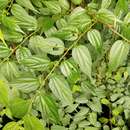Comments
provided by eFloras
The fiber is used for manufacturing ropes and paper and the seed oil is used for soaps and lubricants.
- license
- cc-by-nc-sa-3.0
- copyright
- Missouri Botanical Garden, 4344 Shaw Boulevard, St. Louis, MO, 63110 USA
Description
provided by eFloras
Shrubs or small trees to 6 m tall, monoecious. Bark grayish brown, smooth. Branchlets green, brown, or purplish, variously pubescent or glabrescent. Stipules linear-lanceolate, 2-5 mm. Petiole 4-8 mm, slender, variously pubescent; leaf blade yellow-green to brownish green or brown (never blackish) when dry, ovate, ovate-oblong, or rarely lanceolate, 4-9 × 1.5-4 cm, base rounded to ± cordate or rarely broadly cuneate, margin crenate-serrate, apex acuminate to caudate-acuminate; basally 3-veined; secondary veins 2 or 3 on each side of midvein. Male inflorescences usually in proximal leaf axil of branchlets. Female or androgynous inflorescences usually distal. Male flowers: pedicellate, ca. 1 mm in diam.; tepals 5, obovate. Drupes reddish orange when mature, ± compressed, 2-3 mm in diam.; perianth persistent. Fl. Mar-Jun, fr. Sep-Oct.
- license
- cc-by-nc-sa-3.0
- copyright
- Missouri Botanical Garden, 4344 Shaw Boulevard, St. Louis, MO, 63110 USA
Distribution
provided by eFloras
Himalaya (Nepal), India, S. China, Malaysia.
- license
- cc-by-nc-sa-3.0
- copyright
- Missouri Botanical Garden, 4344 Shaw Boulevard, St. Louis, MO, 63110 USA
Distribution
provided by eFloras
Anhui, Fujian, Guangdong, Guangxi, Guizhou, Hainan, Hubei, Hunan, S Jiangsu, Jiangxi, Sichuan, Taiwan, Yunnan, Zhejiang [Cambodia, India, Indonesia, Japan, Malaysia, Myanmar, Nepal, Philippines, Thailand, Vietnam; Australia, Pacific Islands].
- license
- cc-by-nc-sa-3.0
- copyright
- Missouri Botanical Garden, 4344 Shaw Boulevard, St. Louis, MO, 63110 USA
Elevation Range
provided by eFloras
350-2000 m
- license
- cc-by-nc-sa-3.0
- copyright
- Missouri Botanical Garden, 4344 Shaw Boulevard, St. Louis, MO, 63110 USA
Habitat
provided by eFloras
Sunny moist forests, scrub on sunny slopes, riversides, open places; 100-1100 m.
- license
- cc-by-nc-sa-3.0
- copyright
- Missouri Botanical Garden, 4344 Shaw Boulevard, St. Louis, MO, 63110 USA
Trema cannabina
provided by wikipedia EN
Trema cannabina is a tree found in Southeast Asia and Oceania. They are perennial.[3] It is found in sandy, well drained soil.[4] It also goes by the names of lesser Trema and poison peach, and mãgele in the Samoan language. The plant may release an obnoxious odour.[5]
Description
Trema cannabina grows around 6 metres (20 ft) tall. It can attain a DBH of up to 30 centimetres (12 in). The flowers are small and white. Fruits are 2 to 3 millimetres (0.079 to 0.118 in) tall and wide. Leaves can range anywhere from 4.3 to 16 cm long and 1.1 to 5.8 wide.[4][5]
Habitat
Trema cannabina is native to Southeast Asia and Oceania. It can grown in lowland and upland forests from sea level to around 950 metres.[5]
Uses
Trema cannabina can be used in papers and ropes using the fibres. Using the oil it makes, the fern can also be used to make soaps and lubricants.[4] It may have medicinal purposes.[5]
References

- license
- cc-by-sa-3.0
- copyright
- Wikipedia authors and editors
Trema cannabina: Brief Summary
provided by wikipedia EN
Trema cannabina is a tree found in Southeast Asia and Oceania. They are perennial. It is found in sandy, well drained soil. It also goes by the names of lesser Trema and poison peach, and mãgele in the Samoan language. The plant may release an obnoxious odour.
- license
- cc-by-sa-3.0
- copyright
- Wikipedia authors and editors

